Review: Degradable Magnesium Corrosion Control for Implant Applications
Abstract
:1. Introduction
2. Corrosion Mechanisms of Mg and Its Alloys
2.1. Galvanic Corrosion
2.2. Local Corrosion
- (1)
- Pitting Corrosion
- (2)
- Filiform Corrosion
2.3. High-Temperature Corrosion
2.4. Stress Corrosion
2.5. Corrosion Fatigue
3. Approaches to Magnesium Corrosion Control
3.1. Purification of Mg Alloys
3.2. Micro-Alloying
3.2.1. Zinc
3.2.2. Manganese
3.2.3. Calcium
3.2.4. Rare Earth (RE) Elements
3.3. Grain Refinement
3.3.1. Deformation Processing
- (1)
- Equal Channel Angular Pressing (ECAP)
- (2)
- High-Pressure Torsion (HPT)
- (3)
- Cyclic Extrusion and Pression (CEC)
3.3.2. Sub-Rapid Solidification
3.4. Coating
- (1)
- Bioactive ceramics
- (2)
- Micro-arc Oxidation (MAO) coating
- (3)
- Polymer Films
- (4)
- Chemical Conversion Coating
- (5)
- Metallic Coating
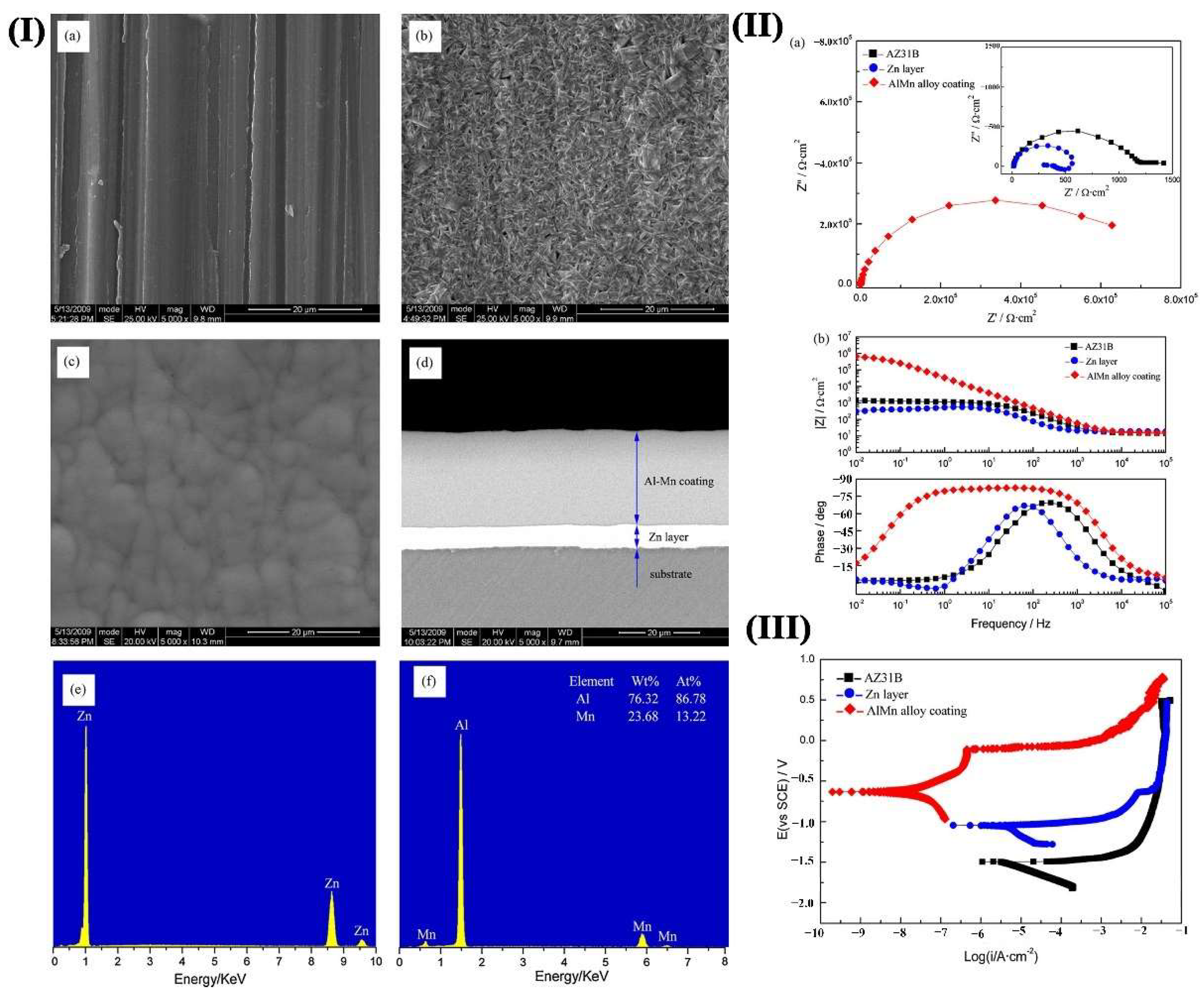
- (1)
- Stress
- (2)
- PH value
- (3)
- Temperature
- (4)
- Solution Composition
4. In Vivo Implantation of Mg Alloys Vascular Stent
5. Future Research Trends and Challenges
6. Summary
Author Contributions
Funding
Institutional Review Board Statement
Informed Consent Statement
Data Availability Statement
Conflicts of Interest
References
- Deng, B.; Dai, Y.L.; Lin, J.G.; Zhang, D.C. Effect of Rolling Treatment on Microstructure, Mechanical Properties, and Corrosion Properties of WE43 Alloy. Materials 2022, 15, 3985. [Google Scholar] [CrossRef] [PubMed]
- Sasaki, M.; Xu, W.; Koga, Y.; Okazawa, Y.; Wada, A.; Shimizu, I.; Niidome, T. Effect of Parylene C on the Corrosion Resistance of Bioresorbable Cardiovascular Stents Made of Magnesium Alloy ‘Original ZM10’. Materials 2022, 15, 3132. [Google Scholar] [CrossRef]
- Staiger, M.P.; Pietak, A.M.; Huadmai, J.; Dias, G. Magnesium and its alloys as orthopedic biomaterials: A review. Biomaterials 2006, 27, 1728–1734. [Google Scholar] [CrossRef] [PubMed]
- Birbilis, N. Magnesium Biomaterials Design, Testing, and Best Practice; Springer: Berlin/Heidelberg, Germany, 2013. [Google Scholar]
- Gu, X.-N.; Li, S.-S.; Li, X.-M.; Fan, Y.-B. Magnesium based degradable biomaterials: A review. Front. Mater. Sci. 2014, 8, 200–218. [Google Scholar] [CrossRef]
- Sezer, N.; Evis, Z.; Kayhan, S.M.; Tahmasebifar, A.; Koç, M. Review of magnesium-based biomaterials and their applications. J. Magnes. Alloy. 2018, 6, 23–43. [Google Scholar] [CrossRef]
- Xue, D.; Yun, Y.; Tan, Z.; Dong, Z.; Schulz, M.J. In Vivo and In Vitro Degradation Behavior of Magnesium Alloys as Biomaterials. J. Mater. Sci. Technol. 2012, 28, 261–267. [Google Scholar] [CrossRef]
- Cui, L.-Y.; Gao, S.-D.; Li, P.-P.; Zeng, R.-C.; Zhang, F.; Li, S.-Q.; Han, E.-H. Corrosion resistance of a self-healing micro-arc oxidation/polymethyltrimethoxysilane composite coating on magnesium alloy AZ31. Corros. Sci. 2017, 118, 84–95. [Google Scholar] [CrossRef]
- Xu, L.M.; Liu, X.W.; Sun, K.; Fu, R.; Wang, G. Corrosion Behavior in Magnesium-Based Alloys for Biomedical Applications. Materials 2022, 15, 2613. [Google Scholar] [CrossRef]
- Lei, B.; Zhang, Z.Q.; Le, Q.C.; Zhang, S.; Cui, J.Z. Corrosion behavior and mechanism of Mg-Y-Zn-Zr alloys with various Y/Zn mole ratios. J. Alloys Compd. 2017, 712, 15–23. [Google Scholar] [CrossRef]
- Witte, F.; Fischer, J.; Nellesen, J.; Crostack, H.-A.; Kaese, V.; Pisch, A.; Beckmann, F.; Windhagen, H. In vitro and in vivo corrosion measurements of magnesium alloys. Biomaterials 2006, 27, 1013–1018. [Google Scholar] [CrossRef]
- Liu, Y.; Liu, X.; Zhang, Z.; Farrell, N.; Zheng, Y. Comparative, real-time in situ monitoring of galvanic corrosion in Mg-Mg2Ca and Mg-MgZn2 couples in Hank’s solution. Corros. Sci. 2019, 161, 108185. [Google Scholar] [CrossRef]
- Zhang, B.; Ma, X. A review—Pitting corrosion initiation investigated by TEM. J. Mater. Sci. Technol. 2019, 35, 1455–1465. [Google Scholar] [CrossRef]
- Song, Y.W.; Shan, D.Y.; Han, E.-H. Pitting corrosion of a Rare Earth Mg alloy GW93. J. Mater. Sci. Technol. 2017, 9, 50–56. [Google Scholar] [CrossRef]
- Ralston, K.D.; Birbilis, N.; Weyland, M.; Hutchinson, C.R. The effect of precipitate size on the yield strength-pitting corrosion correlation in Al–Cu–Mg alloys. Acta Mater. 2010, 58, 5941–5948. [Google Scholar] [CrossRef]
- Sun, Y.H.; Wang, R.C.; Peng, C.Q.; Wang, X.F. Microstructure and corrosion behavior of as-homogenized Mg-xLi-3Al-2Zn-0.2Zr alloys (x = 5, 8, 11 wt%). Mater. Charact. 2020, 159, 110031. [Google Scholar] [CrossRef]
- Li, J.; Chen, Z.; Jing, J.; Hou, J. Effect of yttrium modification on the corrosion behavior of AZ63 magnesium alloy in sodium chloride solution. J. Magnes. Alloy. 2020, 9, 613–626. [Google Scholar] [CrossRef]
- Williams, G.; Grace, R. Chloride-induced filiform corrosion of organic-coated magnesium. Electrochim. Acta 2011, 56, 1894–1903. [Google Scholar] [CrossRef]
- Yu, X.; Jiang, B.; Yang, H.; Yang, Q.; Xia, X.; Pan, F. High temperature oxidation behavior of Mg-Y-Sn, Mg-Y, Mg-Sn alloys and its effect on corrosion property. Appl. Surf. Sci. 2015, 353, 1013–1022. [Google Scholar] [CrossRef]
- Kwon, J.; Baek, S.M.; Jung, H.; Kim, J.C.; Park, S.S. Role of microalloyed Sm in enhancing the corrosion resistance of hot-rolled Mg–8Sn–1Al–1Zn alloy. Corros. Sci. 2021, 185, 109425. [Google Scholar] [CrossRef]
- Yu, Z.; Chen, J.; Yan, H.; Xia, W.; Su, B.; Gong, X.; Guo, H. Degradation, stress corrosion cracking behavior and cytocompatibility of high strain rate rolled Mg-Zn-Sr alloys. Mater. Lett. 2019, 260, 126920. [Google Scholar] [CrossRef]
- Pacha-Olivenza, M.A.; Galván, J.C.; Porro, J.A.; Lieblich, M.; Díaz, M.; Angulo, I.; Cordovilla, F.; García-Galván, F.; Fernández-Calderón, M.; González-Martín, M.; et al. Efficacy of laser shock processing of biodegradable Mg and Mg-1Zn alloy on their in vitro corrosion and bacterial response. Surf. Coat. Technol. 2019, 384, 125320. [Google Scholar] [CrossRef]
- Chen, L.; Blawert, C.; Yang, J.; Hou, R.; Wang, X.; Zheludkevich, M.L.; Li, W. The stress corrosion cracking behaviour of biomedical Mg-1Zn alloy in synthetic or natural biological media. Corros. Sci. 2020, 175, 108876. [Google Scholar] [CrossRef]
- Mirza, F.A.; Chen, D.L.; Li, D.J.; Zeng, X.Q. Low cycle fatigue of an extruded Mg–3Nd–0.2Zn–0.5Zr magnesium alloy. Mater. Des. 2014, 64, 63–73. [Google Scholar] [CrossRef]
- Zeng, R.C.; Jin, Z.; Huang, W.J.; Dietzel, W.; Wei, K.E. Review of studies on corrosion of magnesium alloys. Trans. Nonferrous Met. Soc. China 2006, 16, s763–s771. [Google Scholar] [CrossRef]
- Dai, Y.; Chen, X.-H.; Yan, T.; Tang, A.-T.; Zhao, D.; Luo, Z.; Liu, C.-Q.; Cheng, R.-J.; Pan, F.-S. Improved Corrosion Resistance in AZ61 Magnesium Alloys Induced by Impurity Reduction. Acta Met. Sin-Engl. Lett. 2020, 33, 225–232. [Google Scholar] [CrossRef]
- Ha, W.; Youn, J.I.; Kim, Y.J. Hydrogenation and Degradation Behaviors of Mg-Ni Alloys. In Materials Science Forum; Trans Tech Publications Ltd.: Wollerau, Switzerland, 2007; Volume 539, pp. 1802–1806. [Google Scholar]
- Shao, H.; Xin, G.; Li, X.; Akiba, E. Thermodynamic Property Study of Nanostructured Mg-H, Mg-Ni-H, and Mg-Cu-H Systems by High Pressure DSC Method. J. Nanomater. 2013, 2013, 2527–2531. [Google Scholar] [CrossRef]
- Cain, T.W.; Glover, C.F.; Scully, J.R. The corrosion of solid solution Mg-Sn binary alloys in NaCl solutions. Electrochim. Acta 2018, 297, 564–575. [Google Scholar] [CrossRef]
- Yang, L.; He, S.; Yang, C.; Zhou, X.; Lu, X.; Huang, Y.; Qin, G.; Zhang, E. Mechanism of Mn on inhibiting Fe-caused magnesium corrosion. J. Magnes. Alloy. 2020, 9, 676–685. [Google Scholar] [CrossRef]
- Peng, L.; Zeng, G.; Lin, C.J.; Gourlay, C.M. Al2MgC2 and AlFe3C formation in AZ91 Mg alloy melted in Fe-C crucibles. J. Alloys Compd. 2020, 854, 156415. [Google Scholar] [CrossRef]
- Göken, J.; Letzig, D.; Kainer, K.U. Measurement of crack induced damping of cast magnesium alloy AZ91. J. Alloys Compd. 2004, 378, 220–225. [Google Scholar] [CrossRef]
- Liu, X.-B.; Shan, D.-Y.; Song, Y.-W.; Chen, R.-S.; Han, E.-H. Influence of casting module on corrosion behavior of Mg-11Gd-3Y alloy. Trans. Nonferrous Met. Soc. China 2011, 21, 903–911. [Google Scholar] [CrossRef]
- Wu, G.-H.; Wang, W.; Sun, M.; Wang, Q.-D.; Ding, W.J. Influence of GdCl3 addition on purifying effectiveness and properties of Mg-10Gd-3Y-0.5Zr alloy. Trans. Nonferrous Met. Soc. 2010, 20, 1177–1183. [Google Scholar] [CrossRef]
- Wei, W.; Wu, G.; Wang, Q.; Huang, Y.; Ding, W. Gd contents, mechanical and corrosion properties of Mg-10Gd-3Y-0.5Zr alloy purified by fluxes containing GdCl3 additions. Mater. Sci. Eng. A 2009, 507, 207–214. [Google Scholar]
- Agarwal, S.; Curtin, J.; Duffy, B.; Jaiswal, S. Biodegradable magnesium alloys for orthopaedic applications: A review on corrosion, biocompatibility and surface modifications. Mater. Sci. Eng. C 2016, 68, 948–963. [Google Scholar] [CrossRef]
- Atrens, A.; Song, G.-L.; Cao, F.Y.; Shi, Z.M.; Bowen, P.K. Advances in Mg corrosion and research suggestions. J. Magnes. Alloy. 2013, 1, 177–200. [Google Scholar] [CrossRef]
- Ali, M.; Hussein, M.A.; Al-Aqeeli, N. Magnesium-based composites and alloys for medical applications: A review of mechanical and corrosion properties. J. Alloys Compd. 2019, 792, 1162–1190. [Google Scholar] [CrossRef]
- Shi, F.; Wang, C.Q.; Zhang, Z.M. Microstructures, corrosion and mechanical properties of as-cast Mg-Zn-Y-(Gd)alloys. Trans. Nonferrous Met. Soc. 2015, 25, 2172–2180. [Google Scholar]
- Zhang, Y.; Li, J.; Li, J. Effects of microstructure transformation on mechanical properties, corrosion behaviors of Mg-Zn-Mn-Ca alloys in simulated body fluid. J. Mech. Behav. Biomed. Mater. 2018, 80, 246–257. [Google Scholar] [CrossRef]
- Mahallawy, N.E.; Palkowski, H.; Klingner, A.; Diaa, A.; Shoeib, M. Effect of 1.0 wt. % Zn addition on the microstructure, mechanical properties, and bio-corrosion behaviour of micro alloyed Mg-0.24Sn-0.04Mn alloy as biodegradable material. Mater. Today Commun. 2020, 24, 100999. [Google Scholar] [CrossRef]
- Polina, M.; Guy, B.H.; Yael, T.; Seon, S.K.; Louisa, M. The relation between Mn additions, microstructure and corrosion behavior of new wrought Mg-5Al alloys. Mater. Charact. 2018, 145, 101–115. [Google Scholar]
- Baril, G.; Pébère, N. The corrosion of pure magnesium in aerated and deaerated sodium sulphate solutions. Corros. Sci. 2001, 43, 471–484. [Google Scholar] [CrossRef]
- Wan, D.; Wang, J.; Wang, G.; Chen, X.; Linlin; Feng, Z.; Yang, G. Effect of Mn on damping capacities, mechanical properties, and corrosion behaviour of high damping Mg-3 wt.%Ni based alloy. Mater. Sci. Eng. A 2008, 494, 139–142. [Google Scholar]
- Min, D.; Wang, L.; Daniel, H.; Sviatlana, V.L.; Mikhail, L.Z. Corrosion and discharge properties of Ca/Ge micro-alloyed Mg anodes for primary aqueous Mg batteries. Corros. Sci. 2020, 177, 108958. [Google Scholar]
- Song, G. Control of biodegradation of biocompatable magnesium alloys. Corros. Sci. 2007, 49, 1696–1701. [Google Scholar] [CrossRef]
- Wu, G.; Yu, F.; Gao, H.; Zhai, C.; Yan, P.Z. The effect of Ca and rare earth elements on the microstructure, mechanical properties and corrosion behavior of AZ91D. Mater. Sci. Eng. A 2005, 408, 255–263. [Google Scholar] [CrossRef]
- Wang, D.F.; Zhang, X.L.; Liu, C.; Cheng, T.; Wei, W.; Sun, Y. Transition metal-modified mesoporous Mg-Al mixed oxides: Stable base catalysts for the synthesis of diethyl carbonate from ethyl carbamate and ethanol. Appl. Catal. A Gen. 2015, 505, 478–486. [Google Scholar] [CrossRef]
- Du, Y.; Wang, X.; Liu, D.; Sun, W.; Jiang, B. Corrosion behavior of a Mg–Zn– Ca– La alloy in 3.5 wt% NaCl solution. J. Magnes. Alloy. 2022, 10, 527–539. [Google Scholar] [CrossRef]
- Jin, W.H.; Wang, G.M.; Mateen, A.; Shi, M.; Ruan, Q.D.; Zhou, H.L.; Li, W.; Chu, P.K. Corrosion protection and enhanced biocompatibility of biomedical Mg-Y-RE alloy coated with tin dioxide. Surf. Coat. Technol. 2019, 357, 78–82. [Google Scholar] [CrossRef]
- Ahmad, I.; Bahmanpour, F.; Bakhsheshi-Rad, M.; Reza, H.; Esah, H. Modelling corrosion rate of biodegradable magnesium-based alloys: The case study of Mg-Zn-RE-xCa (x = 0, 0.5, 1.5, 3 and 6 wt%) alloys. J. Alloys Compd. 2016, 687, 630–642. [Google Scholar]
- Liu, M.; Wang, J.; Zhu, S.; Zhang, Y.; Guan, S. Corrosion fatigue of the extruded Mg–Zn–Y–Nd alloy in simulated body fluid. J. Magnes. Alloy. 2020, 8, 231–240. [Google Scholar] [CrossRef]
- Zhang, X.; Yong-Jun, L.I.; Zhang, K.; Wang, C.S.; Hong-Wei, L.I.; Ming-Long, M.A.; Zhang, B.D. Corrosion and electrochemical behavior of Mg-Y alloys in 3.5% NaCl solution. Trans. Nonferrous Met. Soc. 2013, 23, 1226–1236. [Google Scholar] [CrossRef]
- Du, P.; Mei, D.; Furushima, T.; Zhu, S.; Wang, L.; Zhou, Y.; Guan, S. In vitro corrosion properties of HTHEed Mg-Zn-Y-Nd alloy microtubes for stent applications: Influence of second phase particles and crystal orientation. J. Magnes. Alloy. 2022, 10, 1286–1295. [Google Scholar] [CrossRef]
- Liu, W.; Cao, F.; Chang, L.; Zhang, Z.; Zhang, J. Effect of rare earth element Ce and La on corrosion behavior of AM60 magnesium alloy. Corros. Sci. 2009, 51, 1334–1343. [Google Scholar] [CrossRef]
- Yao, S.J.; Yi, D.Q.; Yang, S.; Cang, X.H.; Li, W.X. Effect of Sc on Microstructures and Corrosion Properties of AZ91. Mater. Sci. Forum 2007, 546, 139–142. [Google Scholar] [CrossRef]
- Wang, P.; Li, J.; Ma, Q. Effects of Gadolinium on the Microstructure and Corrosion Resistance Properties of ZK60 Magnesium Alloy. Rare Met. Mater. Eng. 2008, 122, 1640. [Google Scholar]
- Liu, D.; Yang, D.; Li, X.; Hu, S. Mechanical properties, corrosion resistance and biocompatibilities of degradable Mg-RE alloys: A review. J. Mater. Res. Technol. 2018, 8, 1538–1549. [Google Scholar] [CrossRef]
- Prithivirajan, S.; Narendranath, S.; Desai, V. Analysing the combined effect of crystallographic orientation and grain refinement on mechanical properties and corrosion behaviour of ECAPed ZE41 Mg alloy. J. Magnes. Alloy. 2020, 8, 1128–1143. [Google Scholar] [CrossRef]
- Dobkowska, A.; Cielak, B.; Kuc, D.; Hadasik, E.; Mizera, J. Influence of bimodal grain size distribution on the corrosion resistance of Mg-4Li-3Al-1Zn (LAZ431). J. Mater. Res. Technol. 2021, 13, 346. [Google Scholar] [CrossRef]
- Miao, H.; Huang, H.; Shi, Y.; Zhang, H.; Pei, J.; Yuan, G. Effects of solution treatment before extrusion on the microstructure, mechanical properties and corrosion of Mg-Zn-Gd alloy in vitro. Corros. Sci. 2017, 122, 90. [Google Scholar] [CrossRef]
- Wu, P.-P.; Xu, F.-J.; Deng, K.-K.; Han, F.-Y.; Zhang, Z.-Z.; Gao, R. Effect of extrusion on corrosion properties of Mg-2Ca-χAl (χ = 0, 2, 3, 5) alloys. Corros. Sci. 2017, 127, 280. [Google Scholar] [CrossRef]
- Hong, X.U.; Zhang, X.; Zhang, K.; Shi, Y.; Ren, J. Effect of extrusion on corrosion behavior and corrosion mechanism of Mg-Y alloy. J. Rare Earths 2016, 34, 315–327. [Google Scholar] [CrossRef]
- Mineta, T.; Sato, H. Simultaneously improved mechanical properties and corrosion resistance of Mg-Li-Al alloy produced by severe plastic deformation. Mater. Sci. Eng. A 2018, 735, 418–422. [Google Scholar] [CrossRef]
- Omura, Y. Physics-based model for resistance transition of sputter-deposited silicon oxide films. Mater. Today Proc. 2020, 20, 273–282. [Google Scholar]
- Yang, Z.; Ma, A.; Xu, B.; Jiang, J.; Sun, J. Corrosion behavior of AZ91 Mg alloy with a heterogeneous structure produced by ECAP. Corros. Sci. 2021, 187, 109517. [Google Scholar] [CrossRef]
- Zhilyaev, A.P.; Nurislamova, G.V.; Kim, B.-K.; Baró, M.; Szpunar, J.A.; Langdon, T.G. Experimental parameters influencing grain refinement and microstructural evolution during high-pressure torsion. Acta Mater. 2003, 51, 753–765. [Google Scholar] [CrossRef]
- Gao, J.H.; Guan, S.K.; Ren, Z.W.; Sun, Y.F.; Zhu, S.J.; Wang, B. Homogeneous corrosion of high pressure torsion treated Mg–Zn–Ca alloy in simulated body fluid. Mater. Lett. 2011, 65, 691–693. [Google Scholar] [CrossRef]
- Wu, Q.; Zhu, S.; Wang, L.; Liu, Q.; Yue, G.; Wang, J.; Guan, S. The microstructure and properties of cyclic extrusion compression treated Mg–Zn–Y–Nd alloy for vascular stent application. J. Mech. Beh. Biomed. Mater. 2012, 8, 1. [Google Scholar] [CrossRef] [PubMed]
- Gong, Z.; Wang, J.; Sun, Y.; Zhu, S.; Guan, S. Microstructure and mechanical properties of the sub-rapidly solidified Mg―Zn―Y―Nd alloy prepared by step-copper mold casting. Mater. Today Commun. 2021, 27, 102308. [Google Scholar] [CrossRef]
- Zhen, W.A.; Hz, A.; Rwa, B.; Jz, A.; Hw, A.; Sj, A.; Yj, C.; Lh, A. Interface behavior and tensile properties of Mg-14Li-3Al-2Gd sheets prepared by four-layer accumulative roll bonding. J Manufac. Process. 2021, 61, 254–260. [Google Scholar]
- Ma, C.-Y.; Wang, C.; Hua, Z.-M.; Wang, P.-Y.; Wang, J.-G.; Wang, H.-Y. A high-performance Mg-Al-Sn-Zn-Bi alloy fabricated by combining sub-rapid solidification and hot rolling. Mater. Charact. 2020, 169, 110580. [Google Scholar] [CrossRef]
- Liu, D.B.; Liu, Y.C.; Huang, Y.; Song, R.; Chen, M.F. Effects of solidification cooling rate on the corrosion resistance of Mg–Zn–Ca alloy. Prog. Nat. Sci. 2014, 24, 452. [Google Scholar] [CrossRef]
- Mem, A.; Himb, C.; Maw, A.; Ag, D.; Aba, B.; Mst, B. Comparison study of Sn and Bi addition on microstructure and bio- degradation rate of as-cast Mg-4wt% Zn alloy without and with Ca-P coating. J. Alloys Compd. 2019, 792, 1239–1247. [Google Scholar]
- Ng, W.F.; Wong, M.H.; Cheng, F.T. Cerium-based coating for enhancing the corrosion resistance of bio-degradable Mg implants. Mater. Chem. Phys. 2010, 119, 384–388. [Google Scholar] [CrossRef]
- Liu, X.; Morra, M.; Carpi, A.; Li, B. Bioactive calcium silicate ceramics and coatings. Biomed. Pharmacother. 2008, 62, 526–529. [Google Scholar] [CrossRef]
- Witte, F.; Feyerabend, F.; Maier, P.; Fischer, J.; Störmer, M.; Blawert, C.; Dietzel, W.; Hort, N. Biodegradable magnesium–hydroxyapatite metal matrix composites. Biomaterials 2007, 28, 2163–2174. [Google Scholar] [CrossRef] [PubMed]
- Harb, S.V.; Bassous, N.J.; Souza, T.; Trentin, A.; Hammer, P. Hydroxyapatite and β-TCP modified PMMA-TiO2 and PMMA-ZrO2 coatings for bioactive corrosion protection of Ti6Al4V implants. Mater. Sci. Eng. C 2020, 116, 111149. [Google Scholar] [CrossRef]
- Pillai, R.S.; Frasnelli, M.; Sglavo, V.M. HA/β-TCP plasma sprayed coatings on Ti substrate for biomedical applications. Ceram. Int. 2018, 44, 1328–1333. [Google Scholar] [CrossRef]
- Jia, Z.; Li, M.; Liu, Q.; Xu, X.; Wei, S. Fabrication and Characterization of Micro-arc Oxidation(MAO) Coatings on Novel Biodegradable Mg-1Ca Alloy for Orthopaedic Application. Rare Met. Mater. Eng. 2014, 43, 270–275. [Google Scholar]
- Chen, W.-W.; Wang, Z.-X.; Sun, L.; Lu, S. Research of growth mechanism of ceramic coatings fabricated by micro-arc oxidation on magnesium alloys at high current mode. J. Magnes. Alloy. 2015, 3, 253–257. [Google Scholar] [CrossRef]
- Lin, Z.; Wang, T.; Yu, X.; Sun, X.; Yang, H. Functionalization treatment of micro-arc oxidation coatings on magnesium alloys: A review. J. Alloys Compd. 2021, 879, 160453. [Google Scholar] [CrossRef]
- Wu, W.X.; Wang, W.P.; Lin, H.C. A study on corrosion behavior of micro-arc oxidation coatings doped with 2-aminobenzimidazole loaded halloysite nanotubes on AZ31 magnesium alloys. Surf. Coat. Technol. 2021, 416, 127116. [Google Scholar] [CrossRef]
- Zang, D.-M.; Cao, D.-K.; Zheng, L.-M. Strontium and barium 4-carboxylphenylphosphonates: Hybrid anti-corrosion coatings for magnesium alloy. Inorg. Chem. Commun. 2011, 14, 1920–1923. [Google Scholar] [CrossRef]
- Asadi, H.; Suganthan, B.; Ghalei, S.; Handa, H.; Ramasamy, R.P. A multifunctional polymeric coating incorporating lawsone with corrosion resistance and antibacterial activity for biomedical Mg alloys. Prog. Org. Coat. 2021, 153, 106157. [Google Scholar] [CrossRef]
- Yin, Z.-Z.; Qi, W.-C.; Zeng, R.-C.; Chen, X.-B.; Gu, C.-D.; Guan, S.-K.; Zheng, Y.-F. Advances in coatings on biodegradable magnesium alloys. J. Magnes. Alloy. 2020, 8, 42–65. [Google Scholar] [CrossRef]
- Hwang, D.-Y.; Shin, K.-R.; Yoo, B.; Park, D.-Y.; Shin, D.-H.; Lee, D.-H. Characterization of plasma electrolytic oxide formed on AZ91 Mg alloy in KMnO4 electrolyte. Trans. Nonferrous Met. Soc. China 2009, 19, 829–834. [Google Scholar] [CrossRef]
- Rudd, A.L.; Breslin, C.B.; Mansfeld, F. The corrosion protection afforded by rare earth conversion coatings applied to magnesium. Corros. Sci. 2000, 42, 275–288. [Google Scholar] [CrossRef]
- Presuel-Moreno, F.; Jakab, M.; Tailleart, N.; Goldman, M.; Scully, J.R. Corrosion-resistant metallic coatings. Mater. Today 2008, 11, 14–23. [Google Scholar] [CrossRef]
- Wang, Y.; Wu, C.M.; Li, W.; Li, H.Y.; Sun, L.L. Effect of bionic hydrophobic structures on the corrosion performance of Fe-based amorphous metallic coatings. Surf. Coat. Technol. 2021, 416, 127176. [Google Scholar] [CrossRef]
- Li, M.; Akoshima, M. Appropriate metallic coating for thermal diffusivity measurement of nonopaque materials with laser flash method and its effect. Int. J. Heat Mass Transf. 2020, 148, 119017. [Google Scholar] [CrossRef]
- Mda, B.; Mufk, C.; Ys, C.; Cmk, A.; Rkg, C.; Akk, D.; Pk, B.; Mm, B.; Plm, D.; Br, E. Enhanced corrosion resistance and surface bioactivity of AZ31B Mg alloy by high pressure cold sprayed monolayer Ti and bilayer Ta/Ti coatings in simulated body fluid. Mater. Chem. Phys. 2020, 256, 123627. [Google Scholar]
- Nimal, R.; Chenthil, M.; Sangamaeswaran, R.; Hariharan, R.; Esakkimuthu, G. An investigation on microstructural evolution and mechanical properties of Zn coating as interlayer on Mg-Al alloys using diffusion bonding. Mater. Today Proc. 2021, 46, 3512–3516. [Google Scholar] [CrossRef]
- Zhang, W.; Yan, C.; Du, K.; Wang], F. Corrosion behaviors of Zn/Al–Mn alloy composite coatings deposited on magnesium alloy AZ31B (Mg–Al–Zn). Electrochim. Acta 2009, 55, 560. [Google Scholar] [CrossRef]
- Sun, Y.; Pan, Q.; Lin, S.; Zhao, X.; Wang, G. Effects of critical defects on stress corrosion cracking of Al-Zn-Mg-Cu-Zr alloy. J. Mater. Res. Technol. 2021, 12, 1303. [Google Scholar] [CrossRef]
- Wang, B.J.; Xu, D.K.; Sun, J.; Han, E.-H. Effect of grain structure on the stress corrosion cracking (SCC) behavior of an as-extruded Mg-Zn-Zr alloy. Corros. Sci. 2019, 157, 347. [Google Scholar] [CrossRef]
- He, L.; Yang, J.; Xiong, Y.; Song, R. Effect of solution pH on stress corrosion cracking behavior of modified AZ80 magnesium alloy in simulated body fluid. Mater. Chem. Phys. 2021, 261, 124232. [Google Scholar] [CrossRef]
- Johnston, S.; Shi, Z.; Atrens, A. The influence of pH on the corrosion rate of high-purity Mg, AZ91 and ZE41 in bicarbonate buffered Hanks’ solution. Corros. Sci. 2015, 101, 182–192. [Google Scholar] [CrossRef]
- Yang, J.; Blawert, C.; Lamaka, S.V.; Yasakau, K.A.; Zheludkevich, M.L. Corrosion inhibition of pure Mg containing a high level of iron impurity in pH neutral NaCl solution. Corros. Sci. 2018, 142, 222–237. [Google Scholar] [CrossRef]
- Shetty, S.; Nayak, J.; Shetty, A.N. Influence of sulfate ion concentration and pH on the corrosion of Mg-Al-Zn-Mn (GA9) magnesium alloy. J. Magnes. Alloy. 2015, 3, 258–270. [Google Scholar] [CrossRef]
- Tian, Y.; Yang, L.-J.; Li, Y.-F.; Wei, Y.-H.; Hou, L.-F.; Li, Y.-G.; Murakami, R.-I. Corrosion behaviour of die-cast AZ91D magnesium alloys in sodium sulphate solutions with different pH values. Trans. Nonferrous Met. Soc. China 2011, 21, 912–920. [Google Scholar] [CrossRef]
- Jg, A.; Ms, B.; Xm, C.; Gt, D.; Yz, A. Effects of temperature and pH value on the morphology and corrosion resistance of titanium-containing conversion coating. Appl. Surf. Sci. Adv. 2021, 3, 100060. [Google Scholar]
- Medhashree, H.; Shetty, A.N. Electrochemical investigation on the effects of sulfate ion concentration, temperature and medium pH on the corrosion behavior of Mg-Al-Zn-Mn alloy in aqueous ethylene glycol. J. Magnes. Alloy. 2017, 5, 10. [Google Scholar] [CrossRef]
- Liu, P.; Hu, L.; Zhang, Q.; Yang, C.; Yu, Z.; Zhang, J.; Hu, J.; Cao, F. Effect of aging treatment on microstructure and corrosion behavior of Al-Zn-Mg aluminum alloy in aqueous solutions with different aggressive ions. J. Mater. Sci. Technol. 2019, 64, 85–98. [Google Scholar] [CrossRef]
- Nan, Y.H.; Yong, H.; Qiu, K.J.; Liu, Y.; Zheng, Y.F. Influence of biocompatible metal ions (Ag, Fe, Y) on the surface chemistry, corrosion behavior and cytocompatibility of Mg-1Ca alloy treated with MEVVA. Colloids Surf. B 2015, 133, 99. [Google Scholar]
- Dong, H.; Lin, F.; Boccaccini, A.R.; Virtanen, S. Corrosion behavior of biodegradable metals in two different simulated physiological solutions: Comparison of Mg, Zn and Fe. Corros. Sci. 2021, 182, 109278. [Google Scholar] [CrossRef]
- Bergstroem, P.A.; Lindgren, J.; Kristiansson, O. An IR study of the hydration of perchlorate, nitrate, iodide, bromide, chloride and sulfate anions in aqueous solution. J. Phys. Chem. 1991, 95, 8575–8580. [Google Scholar] [CrossRef]
- Furneaux, R.; Thompson, G.; Wood, G. An electronoptical study of the conversion coating formed on aluminium in a chromate/fluoride solution. Corros. Sci. 1979, 19, 63–71. [Google Scholar] [CrossRef]
- Sun, W.; Zhang, G.; Tan, L.; Yang, K.; Ai, H. The fluoride coated AZ31B magnesium alloy improves corrosion resistance and stimulates bone formation in rabbit model. Mater. Sci. Eng. C 2016, 63, 506–511. [Google Scholar] [CrossRef] [PubMed]
- Chandra, G.; Pandey, A. Preparation Strategies for Mg-Alloys for Biodegradable Orthopaedic Implants and Other Biomedical Applications: A Review. IRBM 2022, 43, 229–249. [Google Scholar] [CrossRef]
- Bornapour, M.; Mahjoubi, H.; Vali, H.; Shum-Tim, D.; Cerruti, M.; Pekguleryuz, M. Surface characterization, in vitro and in vivo biocompatibility of Mg-0.3Sr-0.3Ca for temporary cardiovascular implant. Mater. Sci. Eng. C 2016, 67, 72–84. [Google Scholar] [CrossRef] [PubMed]
- Dziuba, D.; Meyer-Lindenberg, A.; Marten, J.S.; Hazibullah, W.; Nina, A. Long-term in vivo degradation behaviour and biocompatibility of the magnesium alloy ZEK100 for use as a biodegradable bone implant. Acta Biomater. 2013, 9, 8548–8560. [Google Scholar] [CrossRef]
- Castellani, C.; Lindtner, R.A.; Hausbrandt, P.; Tschegg, E.; Stanzl-Tschegg, S.E.; Zanoni, G.; Beck, S.; Weinberg, A.-M. Bone–implant interface strength and osseointegration: Biodegradable magnesium alloy versus standard titanium control. Acta Biomater. 2011, 7, 432–440. [Google Scholar] [CrossRef]
- Zhang, S.; Zhang, X.; Zhao, C.; Li, J.; Yang, S.; Xie, C.; Tao, H.; Yan, Z.; He, Y.; Yao, J. Research on an Mg–Zn alloy as a degradable biomaterial. Acta Biomater. 2010, 6, 626–640. [Google Scholar] [CrossRef] [PubMed]
- Erdmann, N.; Angrisani, N.; Reifenrath, J.; Lucas, A.; Thorey, F.; Bormann, D.; Meyer-Lindenberg, A. Biomechanical testing and degradation analysis of MgCa0.8 alloy screws: A comparative in vivo study in rabbits. Acta Biomater. 2011, 7, 1421–1428. [Google Scholar] [CrossRef] [PubMed]
- Han, L.; Xuan, L.; Jing, B.; Feng, X.; Zheng, Y.; Chu, C. Effects of flow velocity and different corrosion media on the in vitro bio-corrosion behaviors of AZ31 magnesium alloy. Mater. Chem. Phys. 2018, 217, 300. [Google Scholar] [CrossRef]
- Schaller, B.; Saulacic, N.; Beck, S.; Imwinkelried, T.; Goh, B.T.; Nakahara, K.; Hofstetter, W.; Iizuka, T. In vivo degradation of a new concept of magnesium-based rivet-screws in the minipig mandibular bone. Mater. Sci. Eng. C 2016, 69, 247–254. [Google Scholar] [CrossRef] [PubMed]
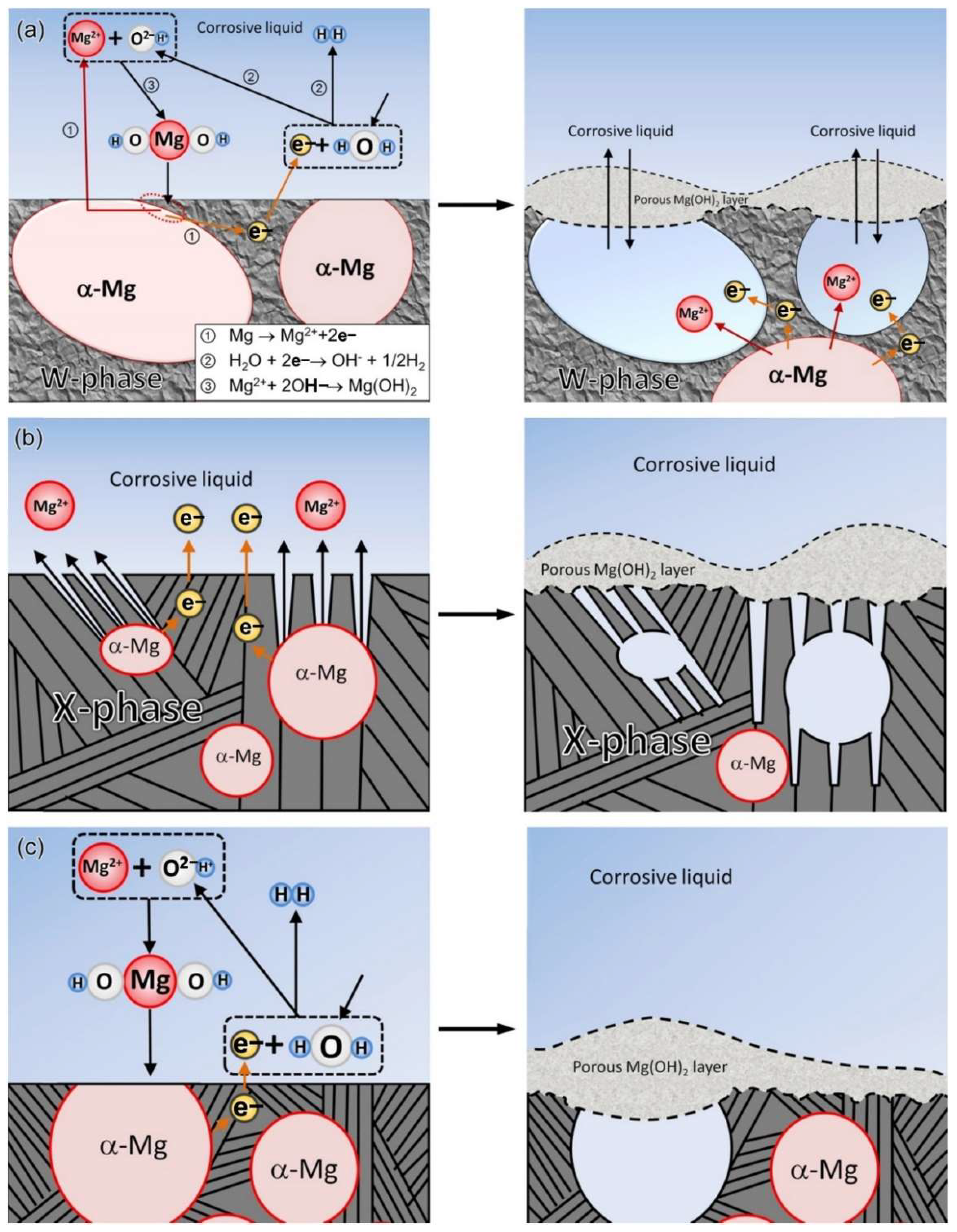
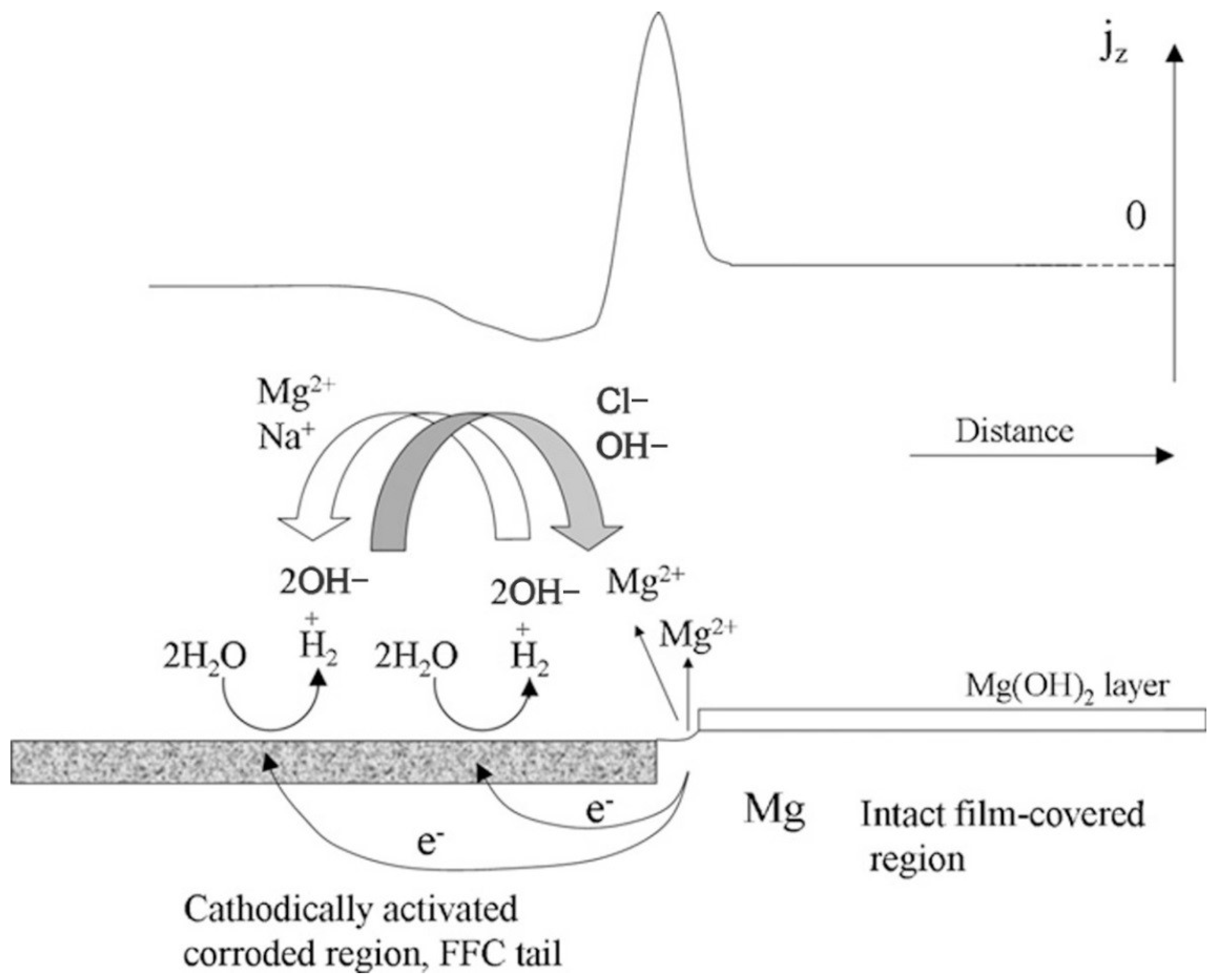
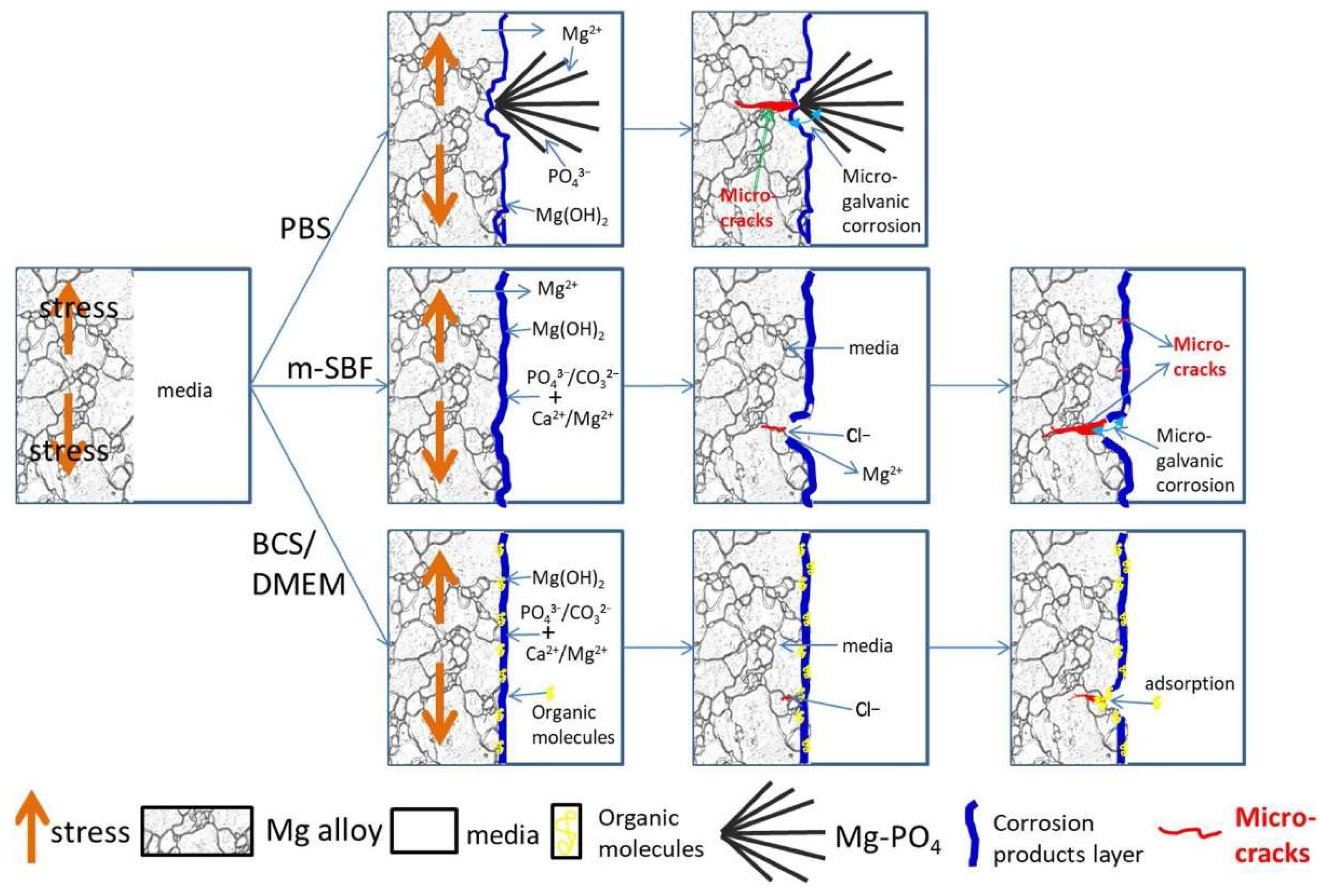

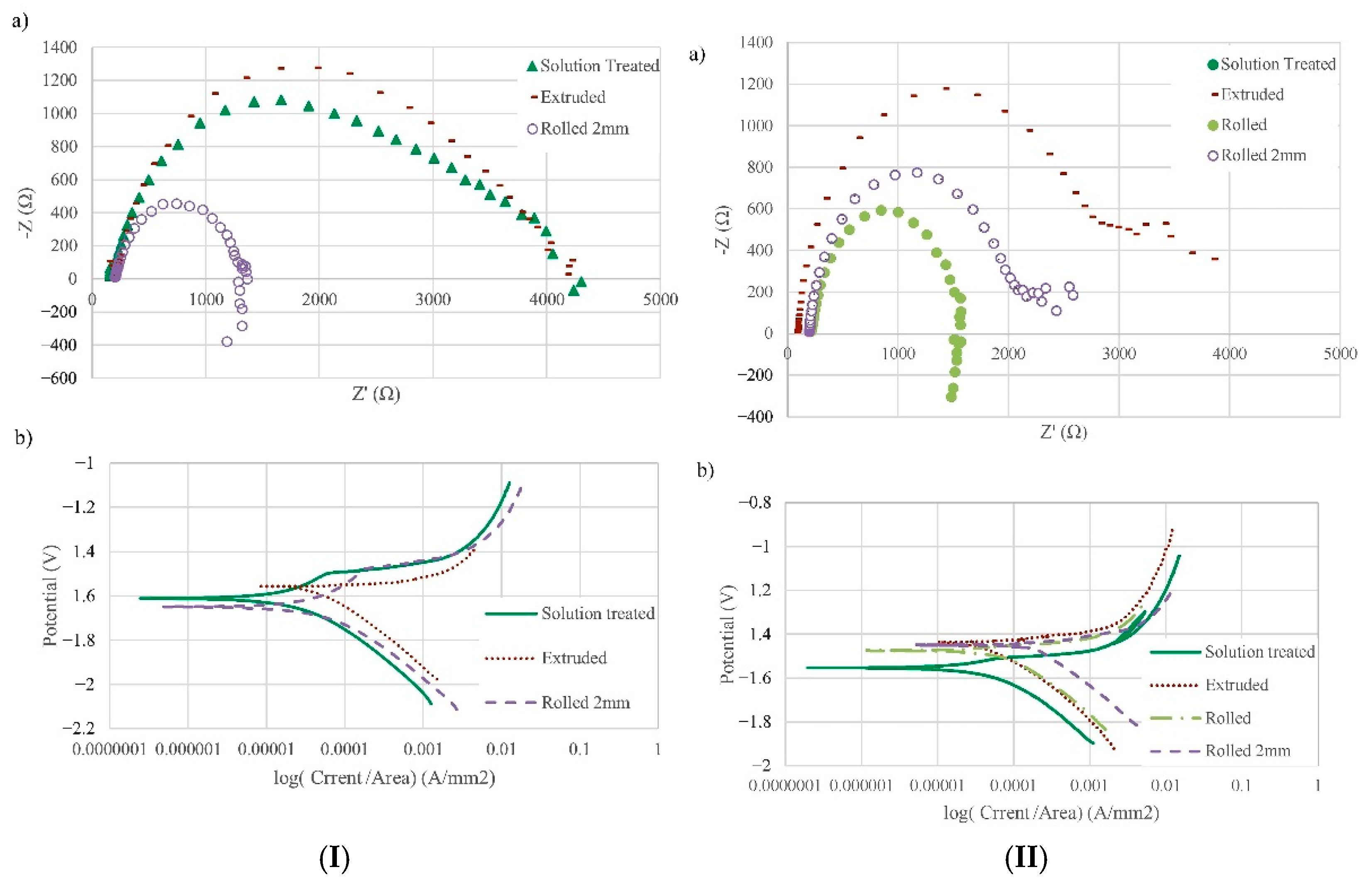

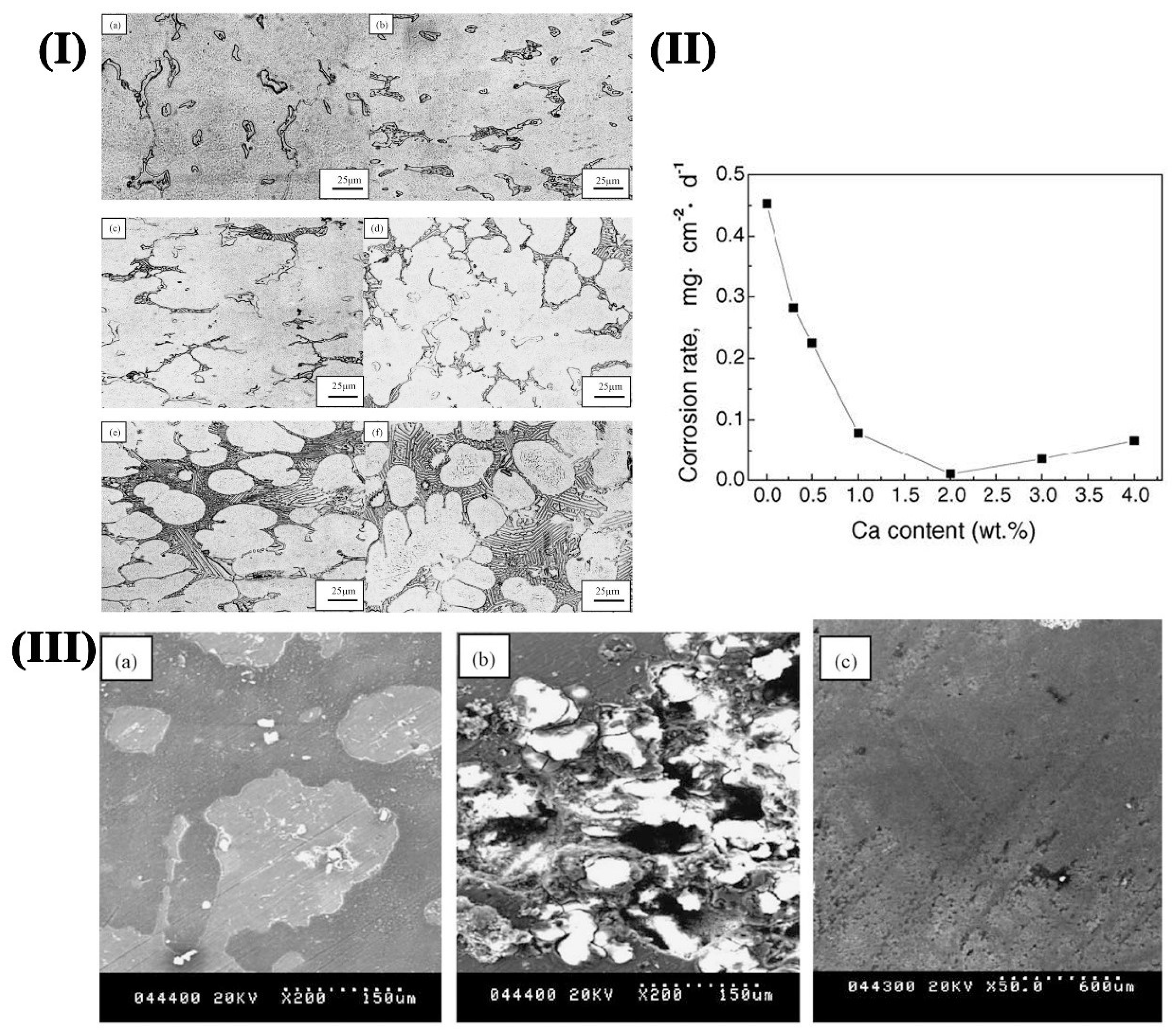
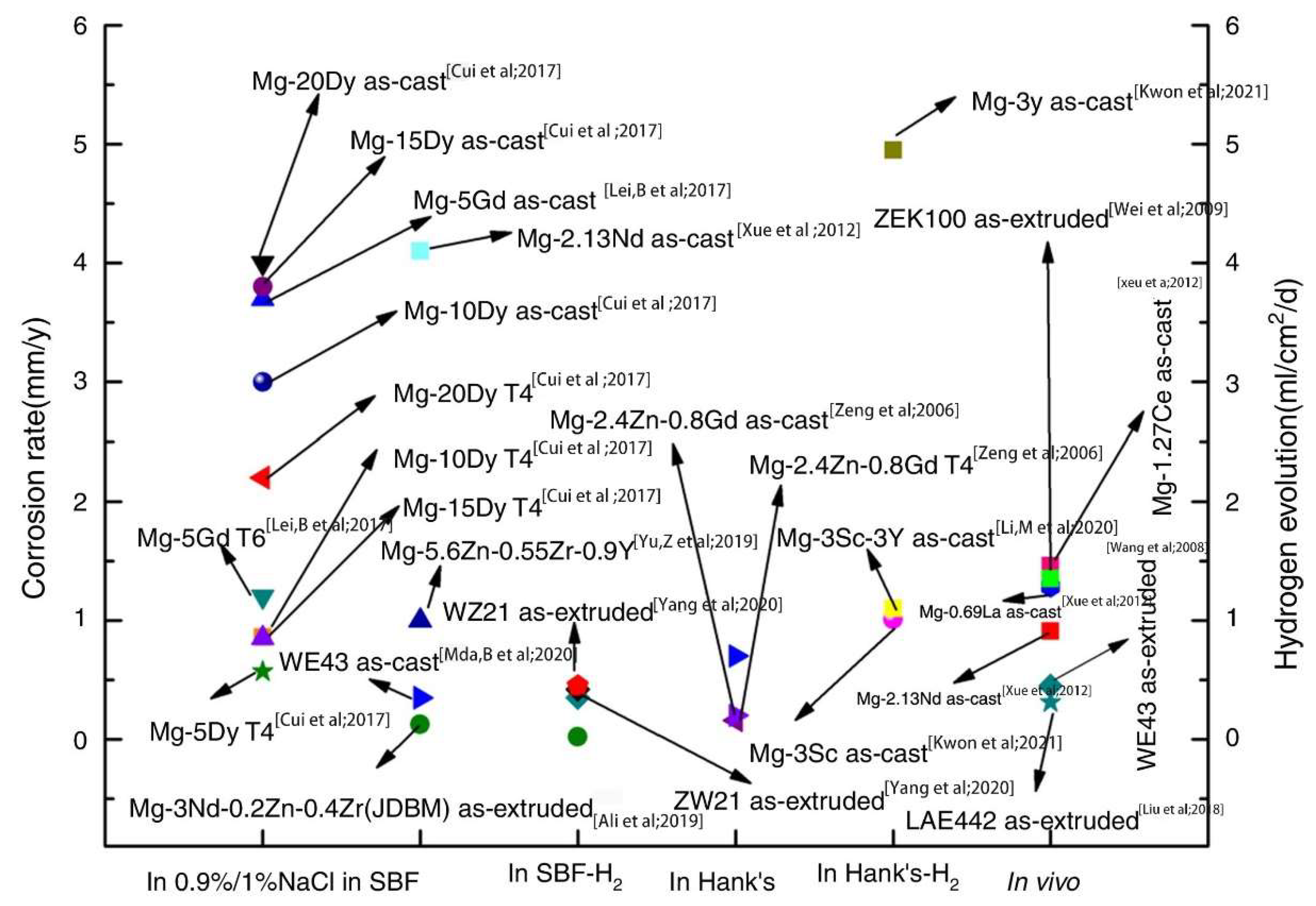
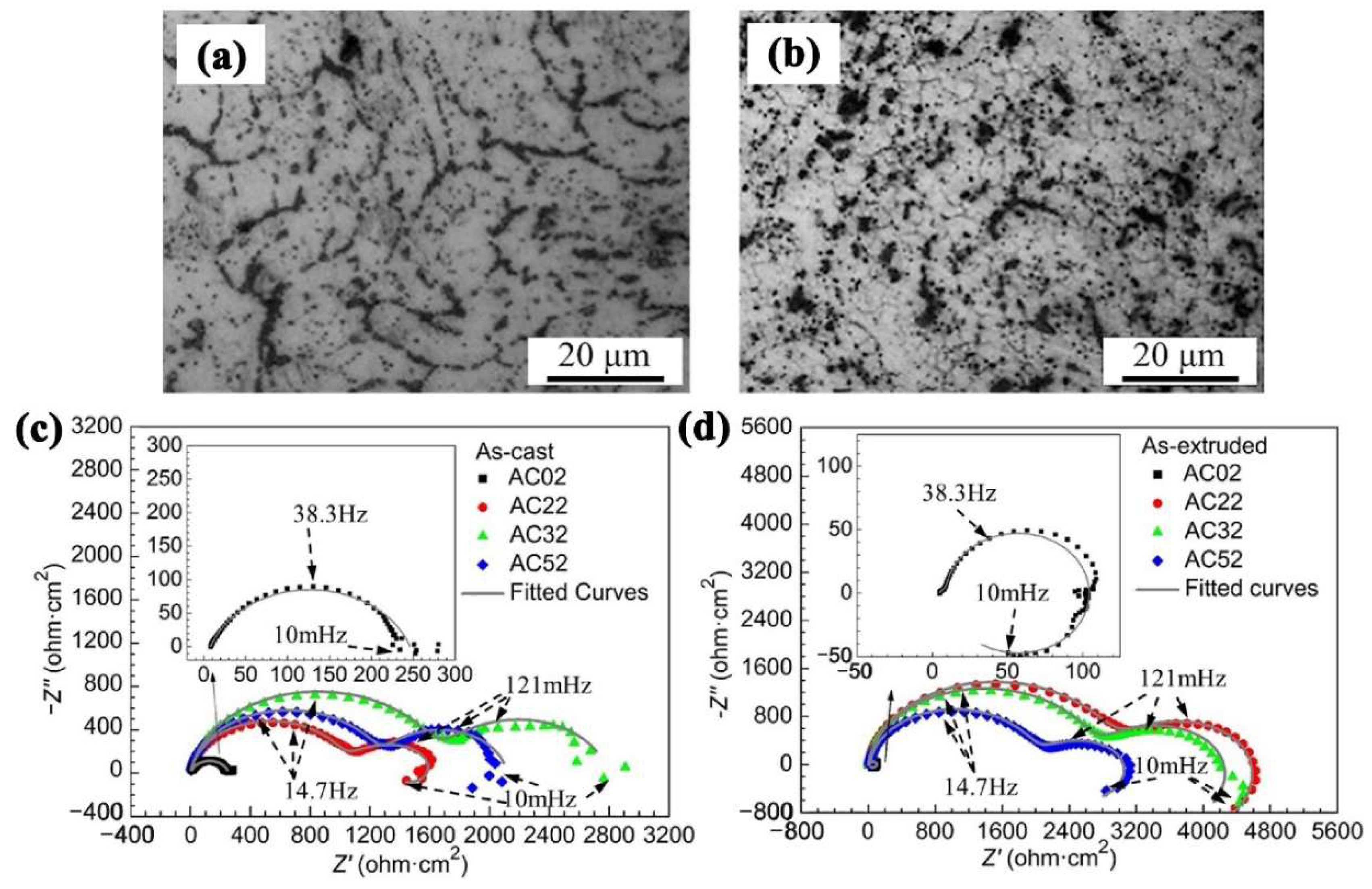

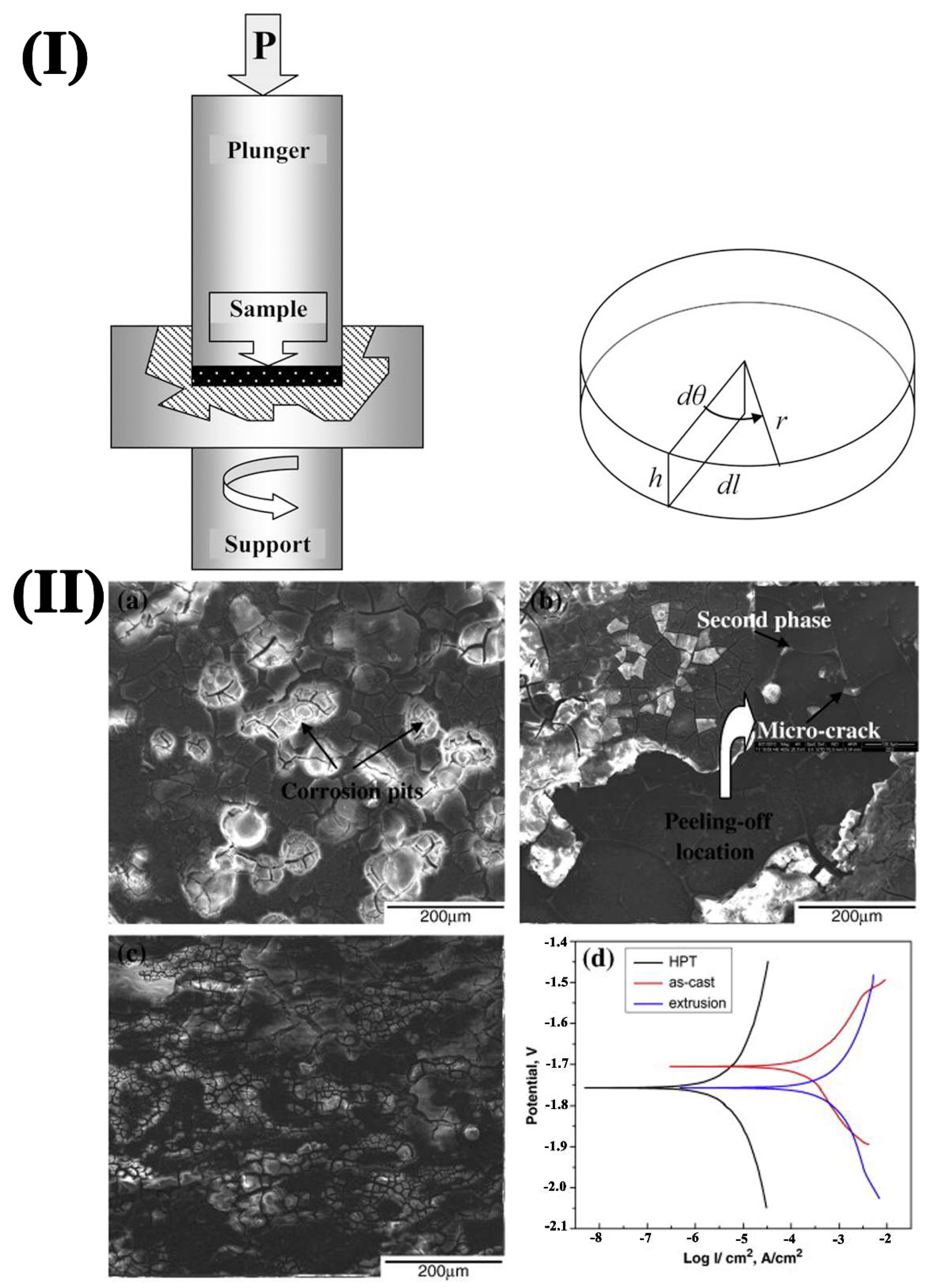
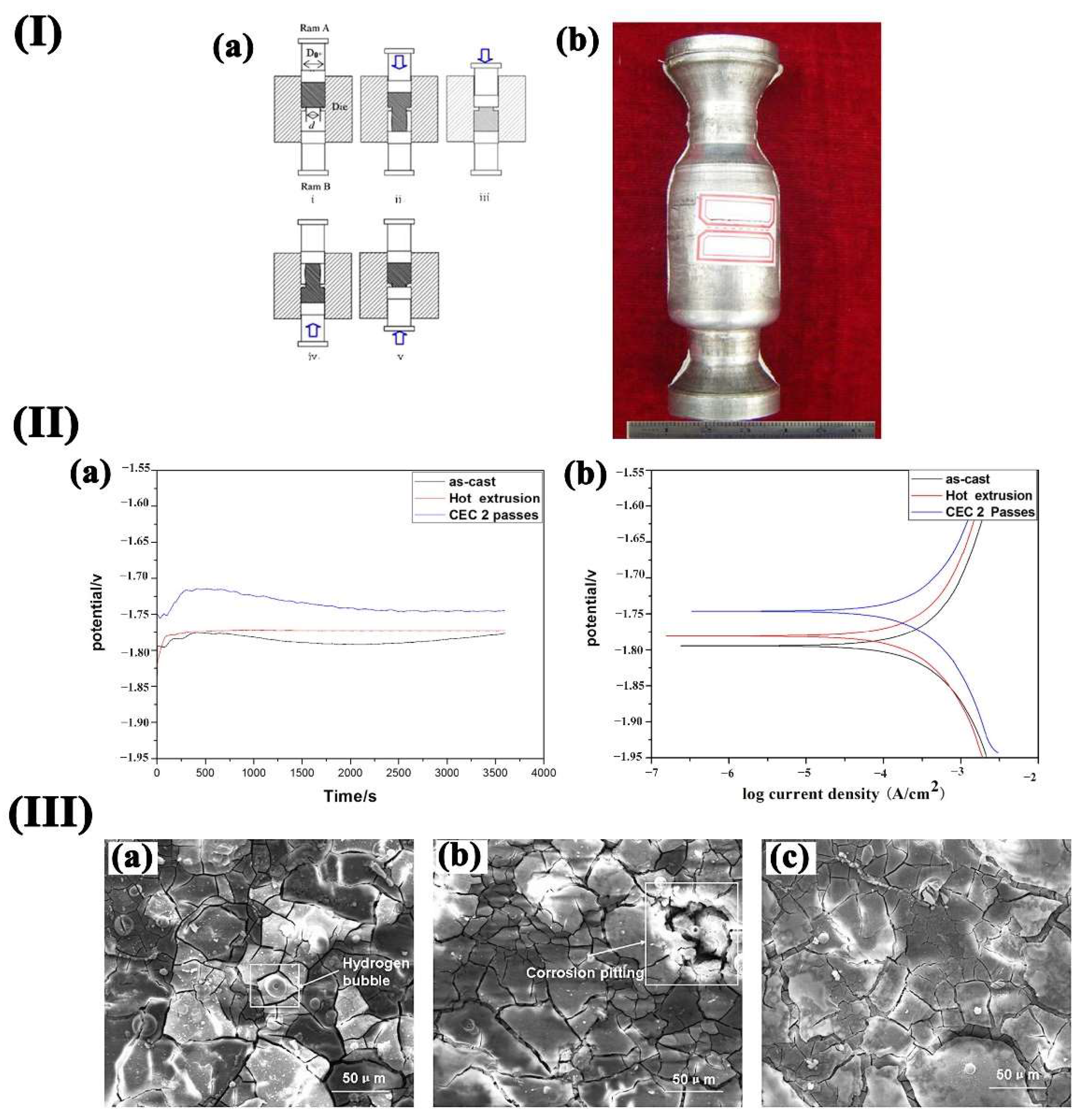
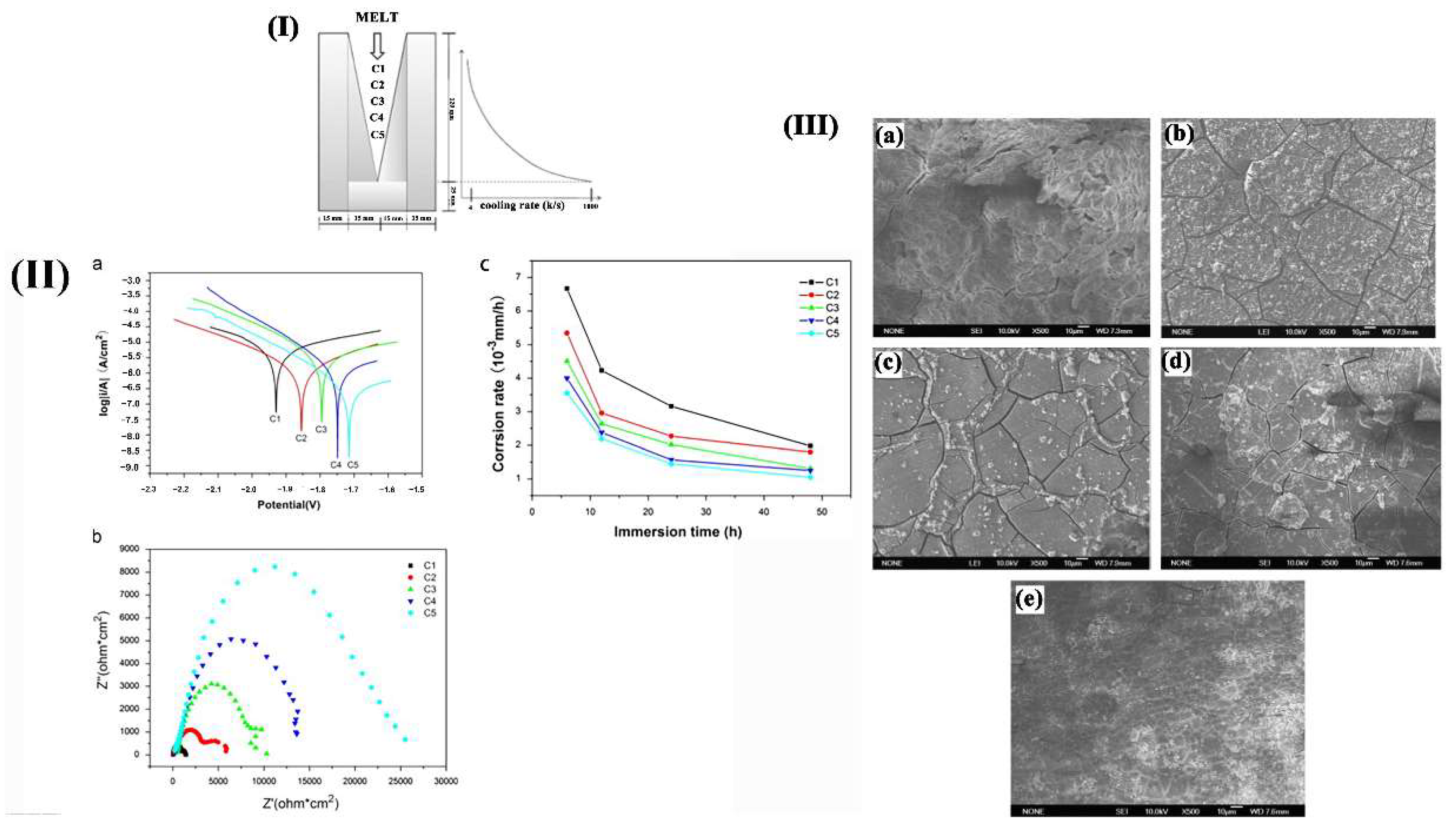
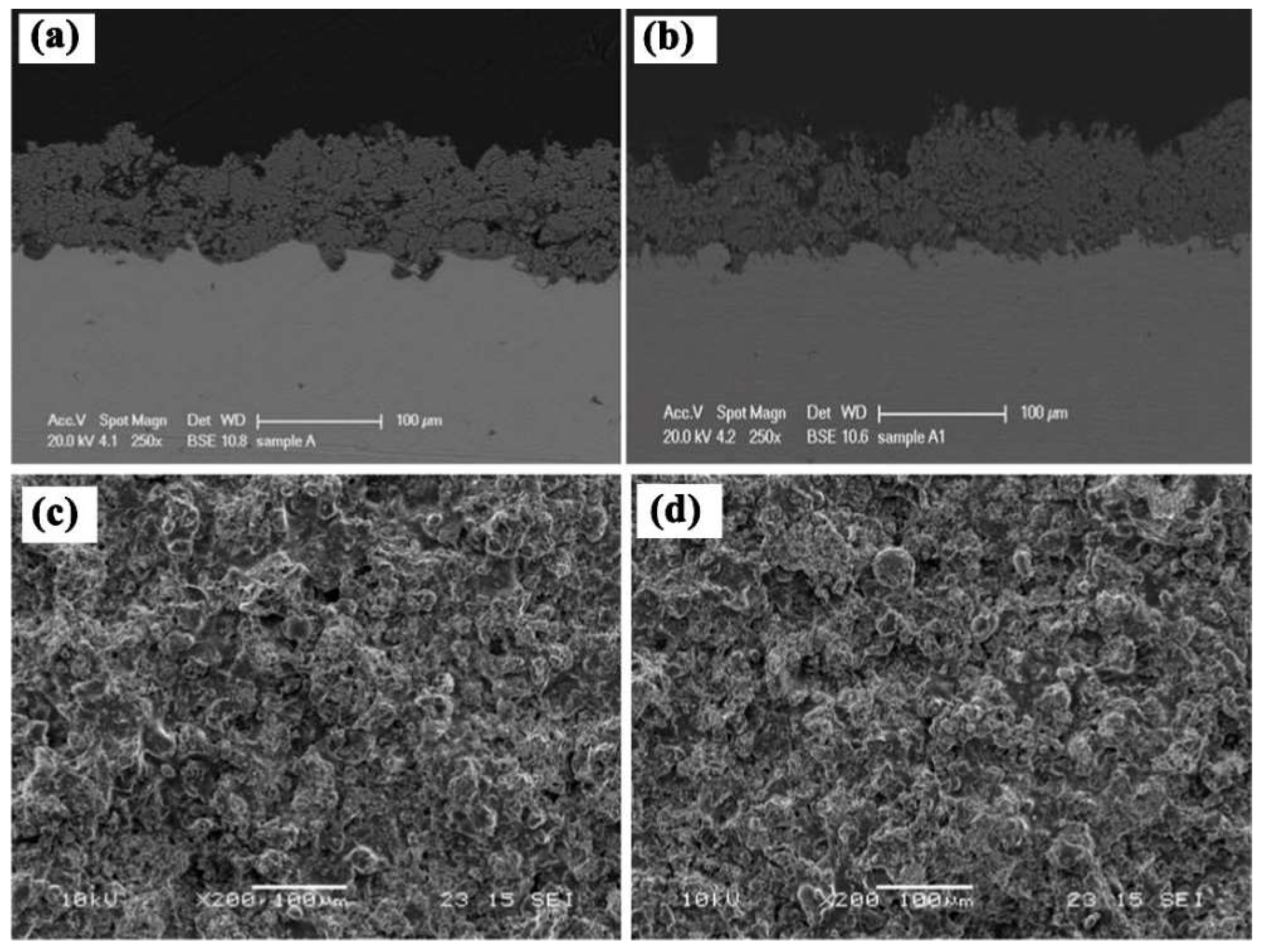
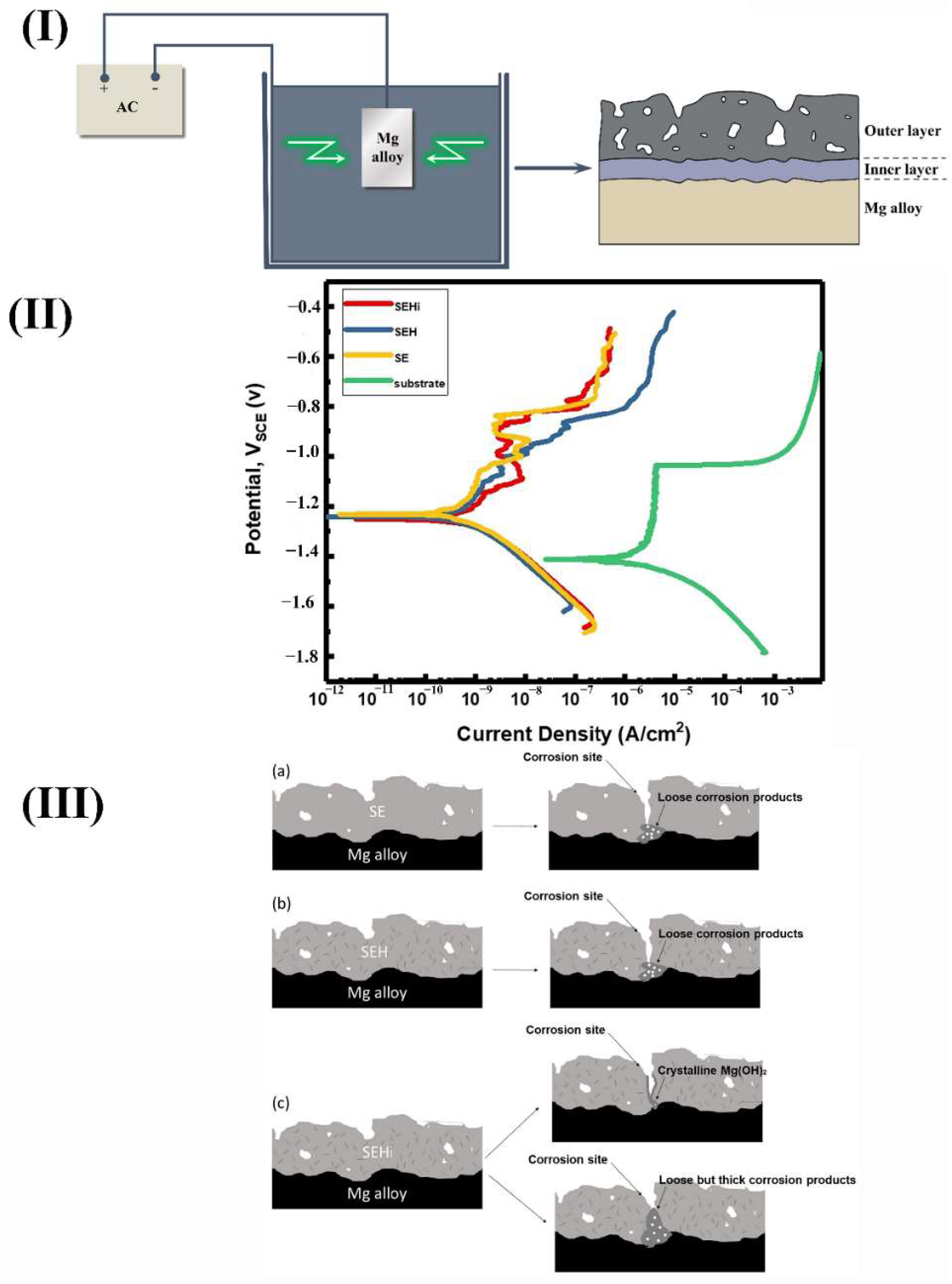
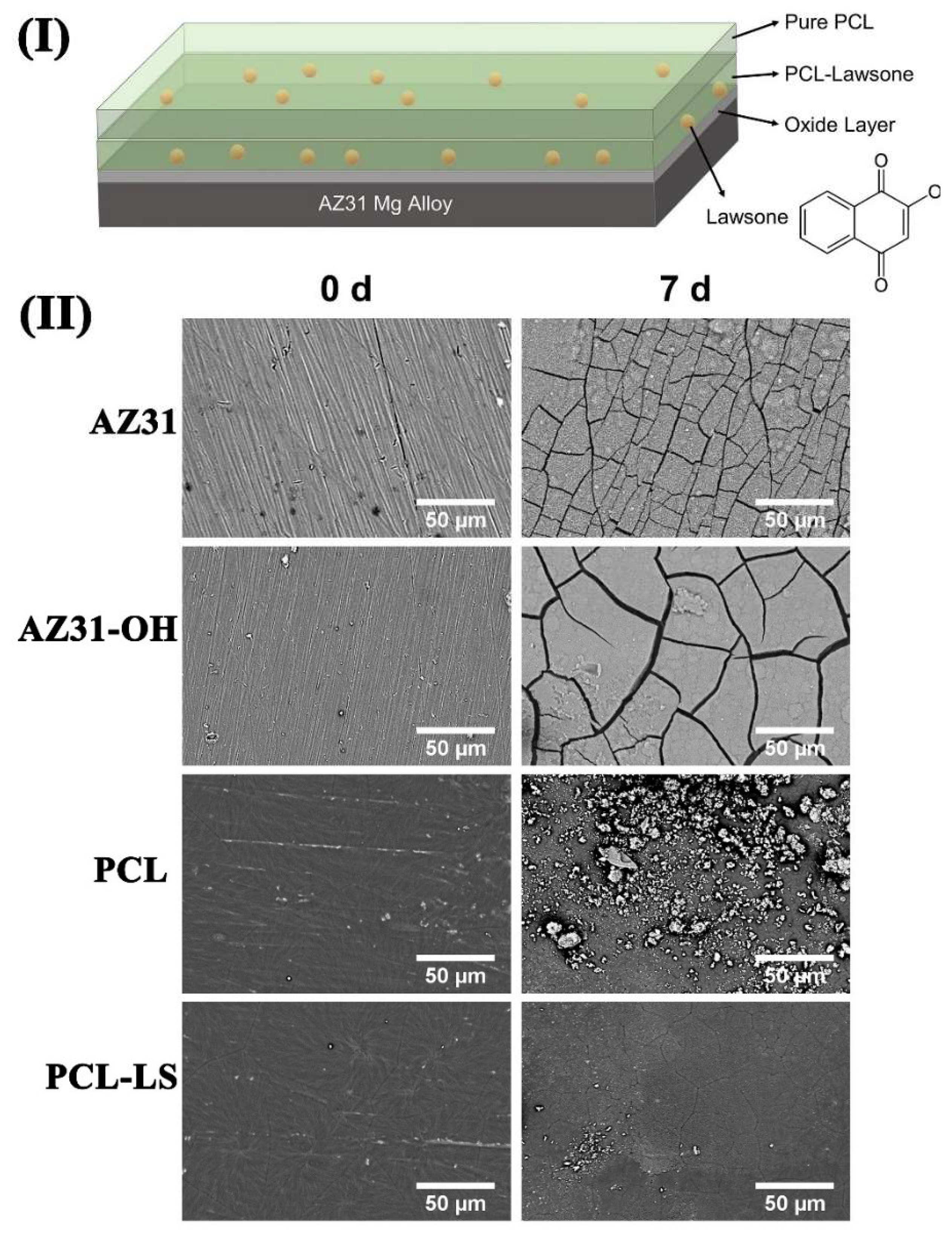
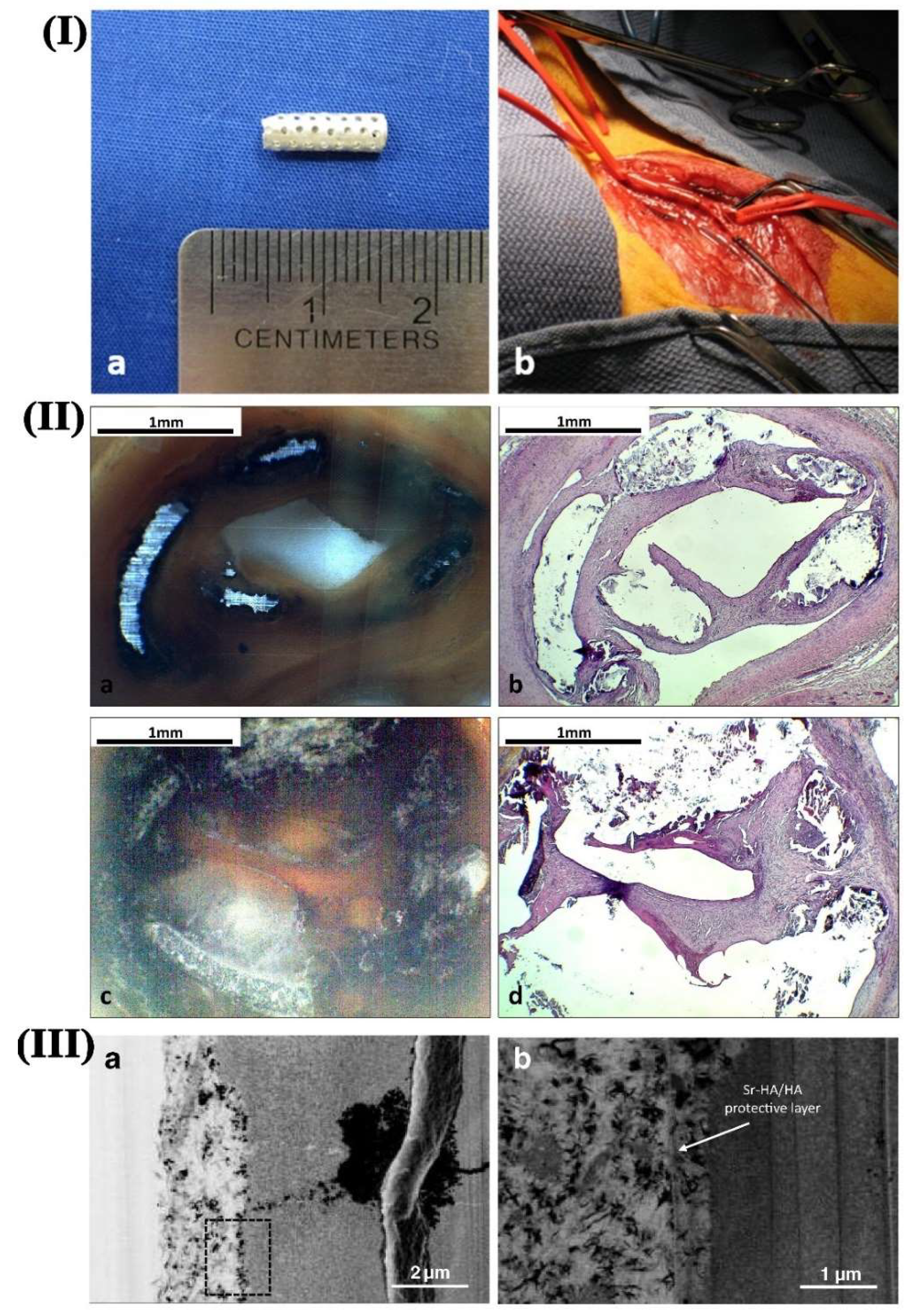
| Classify | Salt Compounds |
|---|---|
| Strong passivator | Fluoride, Chromate |
| Medium passivator | Alkali, Carbonate, Borate, Phosphate |
| Medium etchant | Sulfate, Acetate, Nitrate |
| Pitting corrosion accelerant | Chloride, Bromide, Perchlorate |
| Alloy | Animal Model | Number of Days Implanted | Findings | Reference |
|---|---|---|---|---|
| ZEK100 | Rabbit tibiae | 9 months | Pathological effects on host tissue | [112] |
| Mg-Y-Nd-HRE | Rats Femora | 6 months | Bone-implant interface strength Mg > Ti | [113] |
| Mg-6Zn | Rabbit Femora | 14 weeks | 87% degradation rate | [114] |
| Mg-0.8Ca | Rabbit tibia screw | 8 weeks | Mg-0.8Ca = SS336L at 8th week Inflammation in Mg-0.8Ca > SS336L | [115] |
| Mg-Zn-Ca | Mice Renal vessel occlusion | 4 weeks | Renal vessel was completely closed without any adverse effects | [116] |
| Mg PEO coating Ti | Mini pig Rivet screw | 24 weeks | Bone density and BIC Ti > coated > uncoated Mg | [117] |
Publisher’s Note: MDPI stays neutral with regard to jurisdictional claims in published maps and institutional affiliations. |
© 2022 by the authors. Licensee MDPI, Basel, Switzerland. This article is an open access article distributed under the terms and conditions of the Creative Commons Attribution (CC BY) license (https://creativecommons.org/licenses/by/4.0/).
Share and Cite
Wang, L.; He, J.; Yu, J.; Arthanari, S.; Lee, H.; Zhang, H.; Lu, L.; Huang, G.; Xing, B.; Wang, H.; et al. Review: Degradable Magnesium Corrosion Control for Implant Applications. Materials 2022, 15, 6197. https://doi.org/10.3390/ma15186197
Wang L, He J, Yu J, Arthanari S, Lee H, Zhang H, Lu L, Huang G, Xing B, Wang H, et al. Review: Degradable Magnesium Corrosion Control for Implant Applications. Materials. 2022; 15(18):6197. https://doi.org/10.3390/ma15186197
Chicago/Turabian StyleWang, Lifei, Jianzhong He, Jiawen Yu, Srinivasan Arthanari, Huseung Lee, Hua Zhang, Liwei Lu, Guangsheng Huang, Bin Xing, Hongxia Wang, and et al. 2022. "Review: Degradable Magnesium Corrosion Control for Implant Applications" Materials 15, no. 18: 6197. https://doi.org/10.3390/ma15186197





